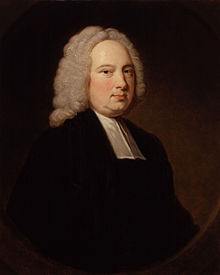
Back جيمس برادلي Arabic Джэймс Брэдлі Byelorussian Джеймс Брадли Bulgarian James Bradley Catalan James Bradley Czech James Bradley Welsh James Bradley Danish James Bradley German Τζέιμς Μπράντλεϋ Greek James Bradley Spanish
James Bradley | |
|---|---|
 Bradley by Thomas Hudson, c. 1744 | |
| Born | September 1692 Sherborne, Gloucestershire, England |
| Died | 13 July 1762 (aged 69) Chalford, Gloucestershire, England |
| Alma mater | Balliol College, Oxford |
| Known for | |
| Children | 1 daughter |
| Awards | Copley Medal (1748) |
| Scientific career | |
| Fields | Astronomy |
| Institutions | |
| Ecclesiastical career | |
| Religion | Christianity (Anglican) |
| Church | Church of England |
| Ordained |
|
James Bradley FRS (September 1692 – 13 July 1762) was an English astronomer and priest who served as the third Astronomer Royal from 1742. He is best known for two fundamental discoveries in astronomy, the aberration of light (1725–1728), and the nutation of the Earth's axis (1728–1748).
These two discoveries were called "the most brilliant and useful of the century" by Jean Baptiste Joseph Delambre, historian of astronomy, mathematical astronomer and director of the Paris Observatory. In his History of astronomy in the 18th century (1821), Delambre stated:[1]
"It is to these two discoveries by Bradley that we owe the exactness of modern astronomy. ... This double service assures to their discoverer the most distinguished place (after Hipparchus and Kepler) above the greatest astronomers of all ages and all countries."